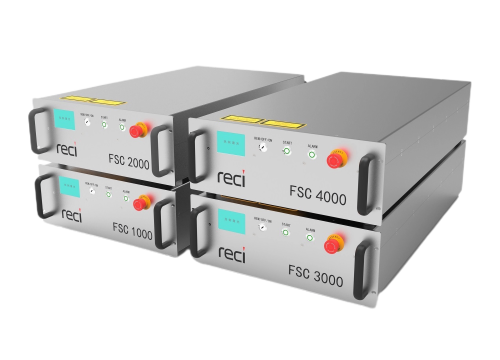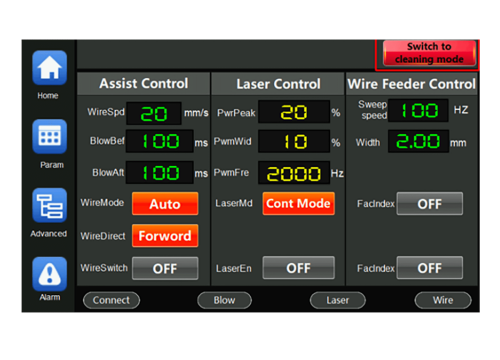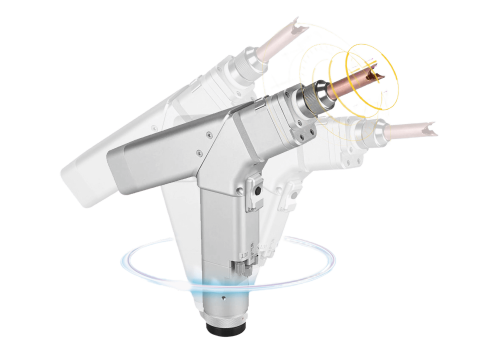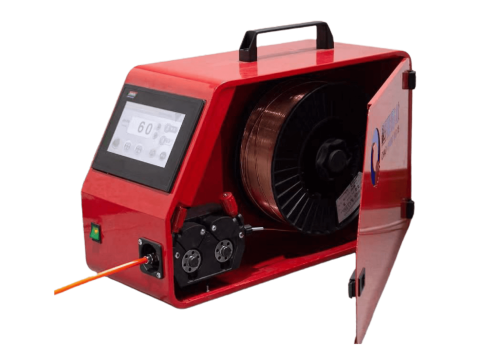- The shipping costs are rising. Contact us for a real-time quote.
- Info@kirinlaser.com
- +86-187-0108-9985
Step into the future of welding excellence with our state-of-the-art handheld fiber laser machines. Ideal for industry professionals seeking unmatched precision, portability, and productivity. A perfect fit for agents and wholesalers seeking efficiency and top-quality results. Transform your welding process today!








Experience the forefront of welding technology with our handheld fiber laser welding machine. Designed for contemporary industrial needs, this device melds formidable strength with exceptional accuracy. It's engineered for adaptability, perfect for various materials and projects, from delicate detailing to heavy-duty tasks.

Usage Applications: Perfect for a variety of materials and fields, such as electronics and heavy metal fabrication.
Energy Efficiency: Offers a selection of power levels (6KW to 9.8KW) for effective energy management.
Consumable Requirements: Few consumables needed, leading to lower costs and less maintenance.
Welding Outcomes: Achieves quick, top-quality welding with no imperfections or color change, removing the need for additional treatment.
Key Benefits: Highly efficient (2-3 times faster than old-school methods), with minimal waste production.
Customizability: Adaptable to meet the specific demands of various industrial applications.

High Efficiency and Power: Air-cooled fiber laser welding machines offer exceptional electro-optic conversion efficiency and robust output power, ideal for intensive welding.
Precision Welding: Superior beam quality ensures precise and clean welds, making these machines perfect for high-quality industrial applications.
Compact and Portable: Designed for ease of mobility, their compact structure makes them suitable for various operational settings, enhancing their versatility.
Customizable and Versatile: Adaptable for a wide range of metal welding and cutting tasks, these machines can be tailored to specific user needs, including unique design customizations.
Effective Cooling and User-Friendly Operation: Incorporating advanced cooling methods for efficient heat management, these welders are simple to operate, offering fast, consumable-free welding speeds.
| Model | Power | Functions | Cooling Method | Spot Size (mm) | Voltage | Dimensions (cm) |
|---|---|---|---|---|---|---|
| KR-1000 | 1000W | Welding, Cutting, Cleaning | Water Cooling | 1.5/1.8/2.0 | 220±20% VAC 50/60Hz | 62.5*174.6*109 |
| KR-1500 | 1500W | Welding, Cutting, Cleaning | Water Cooling | 0.5-5 | 220±20% VAC 50/60Hz | 62.5*175.6*124 |
| KR-2000 | 2000W | Welding, Cutting, Cleaning | Water Cooling | 0.5-5 | 220±20% VAC 50/60Hz | 62.5*175.6*124 |
| KR-3000 | 3000W | Welding, Cutting, Cleaning | Water Cooling | 0.5-5 | 380±20% V AC 50/60Hz | 62.5*178*140 |
| KR-1000A | 1000W | Welding | Air Cooling | 1.5/1.8/2.0 | 220±20% VAC 50/60Hz | 35.2×70×66.6 |
| KR-1500A | 1500W | Welding | Air Cooling | 1.5/1.8/2.0 | 220±20% VAC 50/60Hz | 35.2×70×66.6 |
Hand-Held Fiber Laser Welding: Transforming Modern Fabrication
In the competitive industrial world, hand-held fiber laser welding machines stand out as crucial tools for sectors like automotive, metalwork, and custom fabrication. These machines bring unmatched precision and efficiency, making complex welding tasks surprisingly simple.
As demand for precision grows, these machines are proving to be wise investments. Essential factors to consider include their versatility with different metals, user-friendly design, and advanced laser technology for superior welds.
Maintaining these machines is key to their longevity, ensuring consistent, high-quality performance. Investing in a hand-held fiber laser welder signifies a commitment to excellence and future-readiness in fabrication.
This concise guide offers insights into making informed decisions in this technologically advanced field, helping your business achieve new heights of efficiency and quality with fiber laser welding.
Automotive and Aerospace Industries: Used extensively for precision welding tasks in both manufacturing and repair work, these machines are crucial for automotive production and aerospace components where high precision and reliability are paramount.
Machine Tool and Electronics: Ideal for the machine tool industry for precise welding tasks, and in the electronics sector, they offer unmatched precision, essential for delicate electronic parts and miniaturized components.
Medical Sector: In healthcare manufacturing, these machines provide clean and precise joins in medical devices, ensuring hygiene and reliability, which are critical in medical applications.
Heavy Machinery and Construction: Suitable for robust welding in large structures, they play a vital role in heavy machinery and construction industries, demonstrating versatility in handling large-scale projects.
General Manufacturing and Other Applications: Their adaptability makes them a fit for a broad spectrum of general manufacturing tasks and other diverse industrial applications, offering flexibility, speed, and precision across different sectors.
Step into the realm of enhanced efficiency and precision by selecting the perfect accessories for your handheld fiber laser welding machine. Our free, expertly curated guide leads you through the essentials, from advanced nozzles to precision lenses. Discover top-tier brands and insider tips to transform your welding tasks into seamless, high-quality outcomes. Elevate your machine's performance and your craftsmanship in just a few strategic steps!

Opt for industry leaders like IPG for unparalleled performance, or delve into affordable options like Raycus, Max, and Reci. Keep in mind, selecting the appropriate laser source is crucial for ensuring consistent stability and extended durability in your operations.

Choose smooth operation with intuitive systems like Raytools, or depend on the steadfast performance of Au3tech. The core of your machine's functionality must be both user-friendly and flexible, catering to diverse operational needs seamlessly.

Discover the prowess of our 3-in-1 Laser Welding Head: Innovatively crafted for cleaning, welding, and cutting tasks. Perfectly suited for diverse projects, it guarantees unparalleled precision, efficiency, and flexibility, significantly enhancing operational productivity.

Introducing our Laser Welding Wire Feeder: Multilingual, touch-screen controlled, and remarkably lightweight. Its compact design and automatic wire feeding system streamline your welding process, enhancing efficiency and ease of use in any setting.
Fiber Laser Welding is rapidly becoming the preferred choice over conventional welding technologies globally. Explore the advantages Fiber Lasers bring compared to traditional welding techniques.
1. High Precision and Quality: Fiber laser welding provides exceptional precision, enabling fine, detailed work. This results in high-quality welds with minimal distortion, making it ideal for applications requiring exactness, such as in the medical or aerospace industries.
2. Efficiency and Speed: Due to its concentrated beam and high energy density, fiber laser welding can operate at higher speeds compared to traditional methods. This efficiency leads to increased production rates and lower processing times.
3. Low Heat Input: The focused laser beam minimizes the heat-affected zone (HAZ), reducing thermal distortion and warping of the workpiece. This is particularly beneficial for delicate or heat-sensitive materials.
4. Versatility: Fiber lasers can weld a wide range of materials, including metals that are difficult to weld using conventional methods. This versatility extends to various thicknesses and configurations, making fiber laser welding a flexible solution for diverse applications.
5. Automation and Control: Fiber laser systems can be easily automated and integrated with advanced control systems, providing consistent, repeatable results. This integration is key for large-scale production and complex manufacturing processes.
6. Minimal Maintenance: Fiber lasers have fewer moving parts and consumables compared to traditional welding methods, leading to lower maintenance requirements and reduced downtime.

7. Energy Efficiency: Fiber laser welders are more energy-efficient than conventional welding methods, leading to cost savings and a lower environmental impact over time.
8. Improved Safety: Fiber laser welding often requires less manual intervention and can be operated with minimal exposure to open flames, sparks, and fumes, enhancing workplace safety.
9. Reduced Post-Welding Finishing: The precision and quality of fiber laser welding often reduce the need for extensive post-welding finishing processes, such as grinding or polishing.
10. Deep Weld Penetration: Fiber lasers provide deep weld penetration with a small weld width, enabling strong welds even in challenging geometries.

Gas Shielding: Similar to MIG, TIG also requires an inert gas shield, which can be a factor in operational complexity and environmental impact,


Elevate your business's operational excellence with the right fiber laser welding machine. When navigating this pivotal decision, consider these 10 essential factors to ensure you select a machine that aligns with your specific needs and enhances your production capabilities:
1. Multifunctionality: Determine if you need a machine that only welds or one that also offers cutting and cleaning functions. A versatile, multifunctional machine can provide more value.
2. Material Compatibility: Ensure the machine is compatible with the materials you plan to weld, considering the specific metals and alloys used in your operations.
3. Thickness Range and Precision: Evaluate the machine’s ability to handle the range of material thicknesses you work with, alongside the level of precision it offers for your specific welding tasks.
4. Production Volume and Speed: Assess whether the machine’s speed and efficiency align with your production volume needs, especially in high-throughput environments.
5. Automation and System Integration: Consider the machine’s compatibility with automation and whether it can be integrated into your existing production systems.
6. Workspace and Safety: Make sure your facility can accommodate the machine’s size and that you can adhere to the necessary safety protocols, including proper shielding and eye protection.
7. Operator Skill Requirements: Account for the level of technical skill required to operate the machine and the availability of trained personnel or the need for additional training.
8. Maintenance and Upkeep: Understand the maintenance requirements and ensure that they are manageable within your operational framework.
9. Cost, Budget, and ROI: Balance the initial investment against the long-term return on investment, considering both the machine’s cost and potential operational savings.
10. Warranty, Technical Support, and Compliance: Check the warranty and support services provided by the manufacturer and ensure the machine meets industry standards and regulatory requirements.
In the demanding realm of manufacturing, your equipment's reliability isn't just a benefit – it's essential. The Fiber Laser Welding Machine stands out as a beacon of consistent performance, especially crafted for the rigors of continuous production.

1. Enduring Durability for Uninterrupted Operations
Crafted with top-grade materials and innovative technology, our Fiber Laser Welding Machine is a testament to durability. It’s designed to last, proven by data:
2. Consistent Performance, Day In and Day Out
Reliability means consistent performance under continuous demand. Our machine offers:
3. Warranty and Guarantee – Your Assurance of Quality
We back our Fiber Laser Welding Machine with a solid warranty and guarantee:
| Feature | Our Machine | Industry Standard |
|---|---|---|
| Warranty Period | 2 Years | 1 Years |
| Response Time | 24-Hour Support | 48-72 Hours |
| Component Guarantee | Up to 10,000 Hours | 5,000 Hours |
4. Long-Term Performance for Future-Proof Operations
Invest in a machine that secures your future:

we understand that investing in a fiber laser cutting machine is a significant decision. That's why we've meticulously crafted a process that assures satisfaction, quality, and transparency every step of the way for your reference!





Partner with Us for Advanced Laser Solutions That Set You Apart in the Competitive Market.
Sign up for my newsletter. Do not worry, we will never spam you.
Send us a message if you have any questions or request a quote. We will be back to you ASAP!